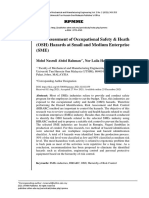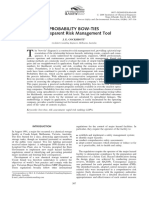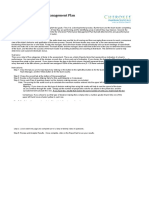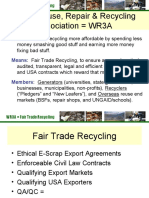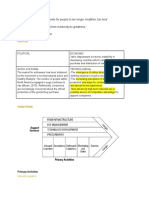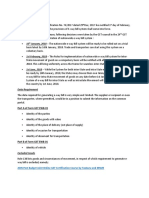Emergency Preparedness and Response in Metallurgical Processes
Emergency Preparedness and Response in Metallurgical Processes
Uploaded by
MK PalermoCopyright:
Available Formats
Emergency Preparedness and Response in Metallurgical Processes
Emergency Preparedness and Response in Metallurgical Processes
Uploaded by
MK PalermoOriginal Title
Copyright
Available Formats
Share this document
Did you find this document useful?
Is this content inappropriate?
Copyright:
Available Formats
Emergency Preparedness and Response in Metallurgical Processes
Emergency Preparedness and Response in Metallurgical Processes
Uploaded by
MK PalermoCopyright:
Available Formats
T.
KARKOSZKA ISSN 0543-5846
METABK 59(2) 215-217 (2020)
UDC – UDK 669.14:669.015:338.95.076.2:331.04=111
EMERGENCY PREPAREDNESS AND
RESPONSE IN METALLURGICAL PROCESSES
Received – Primljeno: 2019-09-25
Accepted – Prihvaćeno: 2019-12-20
Preliminary Note – Prethodno priopćenje
The main aim of the presented paper is to feature the operational model of the emergency preparedness and re-
sponse. It is based on the risk analysis and allows for fulfillment of the requirements of ISO 9001, ISO 14001 and ISO
45001 norms. The model in question represents the base of the real aims’ unification within the range of proceeding
in case of the metallurgical processes’ failures.
Key words: metallurgy, production, emergency preparedness, emergency response, risk analysis
INTRODUCTION gency, in the integrated meaning, can be understood as
the unexpected incident causing the break of the pro-
In connection with globalization, economic develop- cess’ continuity and resulting in the pollutions of the
ment and implementation of “Industry 4.0” proactive environment and occupational accidents as well as loss
creation of the occupational safety in metallurgical pro- of property [10-12].
cesses should be integrated not only with the proceeding Possessing the emergency preparedness and re-
automation but also with quality assurance and environ- sponse model one can simultaneously fulfill formal re-
mental influence minimization [1-3]. The newest ISO quirements of the standards and minimize the risk of the
45001 standard, which describes the guidelines for oc- emergency defined.
cupational health and safety management system [4], can
be a foundation for such an integrated approach. Ten
chapters of the standard are due to, promoted by ISO, METHODOLOGY
new conception of High Level Structure [5]. Its aim is to The methodology of the conducted research includes
provide the univocal requirements and definitions for dif- preparation of the model of emergency preparedness
ferent management systems, especially for the most often and response in the integrated occupational, environ-
implemented ones: quality [6], environmental [7] and the mental and quality range.
occupational safety [4], which in fundamental range reg- It is based on the analysis of the requirements of new
ulate the way of acting resulting in fulfillment of the re- ISO 45001 standard and assessment of practical possi-
quirements and expectations of the external clients, inter- bilities of integration of the occupational safety manage-
ested parties as well as the workers. Those requirements ment system with the other management systems. Ac-
can be understood as a frames for consistent manner of cording to them when deviation arises organization is
objectives achievement. ready to remove or reduce their influences (Operation -
For achieving the further steps of the integration, the 8). Particularly in compliance with Emergency prepared-
methodology of the integration reflecting the models, ness and response (8,6) point organization should identi-
methods and tools is of major strategic importance for fy emergency situations, prevent them and be prepared to
the real integration of the systems [8,9]. The used mod- respond them. Organization prevents and reduces the
el should include the unique procedures and processes undesirable effects (Improvement - 10), especially – what
directed at succeed on operational integration. is required by Incident, nonconformity and corrective ac-
The integration on the operational level is especially tion point (10,2) – controls and corrects the incident,
relevant in the situations when there is no possibility to deals with the consequences, reviews the risk and chang-
assure the compatibility of the realized process with the es the system to minimize it. As the effect of identifica-
planned occupational safety, environmental and quality tion of threats, assessment of the losses and risk accepta-
requirements. In the time of emergency, due to the dif- bility evaluation organization makes a decision on how to
ferent internal or external factors resulting from natural undertake the risk. Therefore, the risk management must
disasters or technological accidents, regular conditions be perceived as the main part of the model. Even though
of work are changed in the special ones. It is accompa- organization is forced by the norms’ requirements to use
nied with the release of the pollutants into the environ- the risk management in the systemic actions, non of
ment and/or causes damage to employees’ health. Emer- standards requires the formalized risk management and
T. Karkoszka, e-mail: tatiana.karkoszka@polsl.pl, Silesian University indicates the concrete risk assessment methods [4,6,7].
of Technology, Gliwice, Poland That is why the starting point for application of the emer-
METALURGIJA 59 (2020) 2, 215-217 215
T. KARKOSZKA: EMERGENCY PREPAREDNESS AND RESPONSE IN METALLURGICAL PROCESSES
gency response is implementation of the developed The emergency preparedness is dedicated towards
method of risk assessment of the calculation character. minimization of the risk concerning the probability of the
The guidelines for risk assessment, which can be used as emergency. The emergency response is targeted at mini-
an element of emergency response, have been described mizing the risk connected with the threats resulting in the
in the following scientific papers [13-15] as the subject of occurrence of the influences on the environment as well
the author’s study. as the occupational diseases and the accidents at the
Emergency preparedness and response has been pre- workplace. It remains both as the actions undertaken im-
pared as a tool for process’ safety assurance in the qual- mediately after the emergency and as the preventive
ity, environmental and occupational safety context, es- ones. In the case of the reactive character it is included in
pecially for every metallurgical process. the improvement phase. Than it has a significant impact
on limitation of the emergency risk by minimizing both:
RESULTS IN METALLURGICAL PROCESS probability of occurrence and significance of effects.
Emergency preparedness should be interpreted as
The model includes the organizational and techno-
the reduction of the probability of the emergency and its
logical solutions used by the organization both to prevent
effects occurrence (OS2 < O1) and the minimization of
and to react to the effects of occupational threats, quality
the risk of the emergency (RS1 < R1). In contrast, assur-
incompatibilities and environmental influences, which
ance of the supervised conditions during the emergency
have already occurred in the dangerous situations. Emer-
situation should be understood as the limitation of the
gency response should be implemented when emergency
effects of the emergency, in the meaning of effects sig-
preparedness, aimed at stopping the accident by monitor-
nificance (SS2 < SS1) and minimization of the risk of the
ing of the identified operational criteria, is insufficient
occurred emergency (RS2 < R1).
and the emergency happens, see Figure 1.
The influences of the emergency, being embodied in
The base for procedure of emergency preparedness
the organization despite the emergency preparedness
and response is risk assessment. It indicates tools and
and the actions undertaken for the sake of the emergen-
methods for processes’ control and supervision. It ena-
cy are the subject of the analysis being in the same time
bles to point the solutions appropriate for the process
the inputs for the improvement process. The new im-
and describes human and intangible resources as well as
proved solutions of the emergency actions are directed
documentation specific for the concrete emergency.
at the limitation of both: emergency influence signifi-
When, during realization of the process and assur-
cance (SS3 < SS2) and emergency influence occurrence
ance of the supervised conditions, the compatibility of
(OS3 < OS1) and finally – minimizing the risk of the po-
the operational criteria with the requirements is not
tential emergency (RS3 < RS1, RS3 < RS2).
guaranteed, the conditions of dangerous situation occur.
It should be underlined that the above-mentioned ac-
When the effects of the meaningful threats became the
tions shouldn’t be treated as the one time activities but
real ones, the response to the effects of the threats based
as the continuous and repeatable ones. Propositions of
on the quality, environmental and occupational health
the preparedness and response actions in the chosen
and safety criteria are needed.
metallurgical processes have been shown in the Table 1.
After-emergency response acts also as the re-active
monitoring including the analysis of organizational and
technical factors creating such process’ conditions as can CONCLUSIONS
cause the accident. The results of the analysis are crucial
for identification of possibilities of process’ improve- Harmonizing the management systems according to
ment and assessment of the risk connected with them. the HLS can be considered only a starting point for the
Figure 1 Model of the emergency preparedness and response including scheme of risk minimization.
216 METALURGIJA 59 (2020) 2, 215-217
T. KARKOSZKA: EMERGENCY PREPAREDNESS AND RESPONSE IN METALLURGICAL PROCESSES
Table 1 Summary of the exemplary preventive and response actions.
Preventive/response Aim of the instruction Chosen preventive/response emergency actions
instructions
Emergency preparedness
Using the machines Characterisation of the safety manner Technological instruction of the continuous casting machine
and installations of using the installation in the normal operation
Monitoring the machines Identification of the situations connected with Condition based maintenance of the engines
and installations obsolescence of the installation and its corrosion of pulling rollers of the continuous casting machine
Threats’ analysis Regular assessment of the risk of the emergency Identification of potential emergencies, their risk assessment
and risk assessment situations for all of the CSC devices, preparation of the emergencies
response plans
Trainings for employees Identification of the training needs, provision Trainings concerning the continuous casting process,
and subcontractors of training and verification of their effects particularly machine design and operations as well as their
connection with cast defect-free products
Operational control Maintenance of the operational criterions in the Control of : particulate matter, sulphur dioxide, nitrogen
supervised conditions dioxide, carbon monoxide
Emergency response
Actions after process’ Determining ways to restore machine / Repairing the ladle crane according
discontinuity installation to normal operation to the prepared emergency response plan
Environmental Laying down rules of conduct with environmental Reduction of uncontrolled particulate matter emission, with
emergency actions influences of the emergency cooperation with environmental emergency plan
Occupational accident Laying down rules of conduct at the time Risk reduction, first medical treatment, call of emergency
actions of occupationally dangerous emergencies services, with cooperation with designed procedures
integration of the implemented systems. In practice REFERENCES
“Operational control” requirement points the duty to
plan and realize the operational actions minimizing the [1] J. Łuczak, R. Wolniak, Integration of quality, environment
and safety management systems in a foundry, Metalurgija
risks, which are different in various systems. 55 (2016) 4, 843-845.
Dependently on the operational criteria organiza- [2] B. Gajdzik, Changes in steel enterprises in direction of In-
tions face a dilemma how to fulfill the integrated re- dustry 4.0, Metallurgist 86 (2019) 7, 211-215.
quirements on the operational level. Therefore research [3] H. Peters, Industry 4.0 as the basis of modern metallurgical
directed at searching the manners of the effective inte- innovations, Chernye Metally (2017) 7, 56-63.
[4] ISO 45001 Occupational health and safety management
gration in the range of operational control are necessary.
systems, ISO, Genève, 2017.
In the metallurgical industry, in the conditions of the [5] ISO/IEC Directives, part 1, Consolidated ISO supplement,
more and more demanding requirements in regard to the Procedures specific to ISO, ISO, Genève, 2017.
quality, environmental and occupational safety, modeling [6] ISO 9001 Quality management systems, ISO, Genève, 2015.
the authorial solutions – to fit around the individual needs [7] ISO 14001 Environmental management systems, ISO,
of every organization – used in the integration of the Genève, 2015.
[8] M. Bernardo, A. Simon, Multiple standards: is this the fu-
management systems seems to be increasingly difficult. ture for organizations, Proceedings of the 28th EGOS Col-
The proposed model may be an option of such a solution. loquium on Design, Helsinki, July 5-7, 2012.
It provides the conditions of “the supervised risk” in the [9] M. Majerník, N. Daneshjo, J. Chovancová, G. Sančiová,
emergency situations. Emergency preparedness reflects Design of integrated management systems according to the
the preventive actions. After-emergency immediate ac- revised ISO standards, Polish Journal of Management Stu-
tions allow the reduction of the emergency influence. Re- dies 15 (2017) 1, 135-143.
[10] UNEP/GC.22/INF/5, Further improvement of envi-
active monitoring enables the organization to limit emer- ronmental emergency prevention, preparedness, asses-
gency influence both significance and occurrence. Emer- sment, response and mitigation, United Nations, 2002.
gency preparedness and response can be, consequently, [11] Joint UNEP/OCHA Environment Unit, Guidelines for en-
applied as a the tool for minimizing the risk of both: oc- vironmental emergencies, New York and Geneva, 2009.
curred and potential emergency. [12] J. C. Pine, Technology and emergency management, John
Wiley & Sons, Inc., Hoboken, 2018.
Implementation of the model in the metallurgical
[13] T. Karkoszka, Operational control with application of the
processes, including continuous steel casting, can be risk analysis in the integrated management system of
treated as the own manner of fulfillment of the require- technological process, Silesian Technical University Pu-
ments of “Industry 4.0”. blishing House, Gliwice, 2017.
[14] T. Karkoszka, M. Soković, Risk based on quality, envi-
ronmental and occupational safety in heat treatment pro-
Acknowledgement cesses, Metalurgija 53 (2014) 4, 545-548.
[15] T. Karkoszka, Conditions of the supervised risk in the zinc
The publication was supported by the statutory grant coating processes, Metalurgija 58 (2019) 1-2, 147-150.
of Faculty of Mechanical Engineering, Silesian Univer- Note: The professional translator responsible for English language is
sity of Technology in the year 2019. Dominika Wnukowska, Katowice, Poland.
METALURGIJA 59 (2020) 2, 215-217 217
You might also like
- Risk Assessment Procedure: Daqing Petroleum Iraq BranchDocument10 pagesRisk Assessment Procedure: Daqing Petroleum Iraq Branchkhurram100% (1)
- Furred Up - A PET CARE APPLICATIONDocument54 pagesFurred Up - A PET CARE APPLICATIONRadhika TikmaniNo ratings yet
- An Overview of Emergency Relief System Design Practice: HaroldDocument12 pagesAn Overview of Emergency Relief System Design Practice: HaroldAzar DeenNo ratings yet
- Incorporating Resilience Into Business Continuity and Emergency Management For The Petroleum and Process IndustryDocument12 pagesIncorporating Resilience Into Business Continuity and Emergency Management For The Petroleum and Process IndustryypzoNo ratings yet
- Sales Promotion On HyundaiDocument80 pagesSales Promotion On HyundaiAbhishek Gupta33% (6)
- E3sconf Icepp2021 03003Document8 pagesE3sconf Icepp2021 03003ext.diego.paulinoNo ratings yet
- Oil Gas Offshore Safety Case (Risk Assessment) : August 2016Document44 pagesOil Gas Offshore Safety Case (Risk Assessment) : August 2016Andi SuntoroNo ratings yet
- Poster 05Document11 pagesPoster 05mohamedNo ratings yet
- Oil Gas Offshore Safety Case (Risk Assessment) : Pbt750@mun - CaDocument43 pagesOil Gas Offshore Safety Case (Risk Assessment) : Pbt750@mun - CaUlviyye ElesgerovaNo ratings yet
- Oil Gas Offshore Safety Case (Risk Assessment) : Pbt750@mun - CaDocument43 pagesOil Gas Offshore Safety Case (Risk Assessment) : Pbt750@mun - CaUlviyye ElesgerovaNo ratings yet
- Ch-7 - Risk AnalysisDocument32 pagesCh-7 - Risk AnalysisDebayanbasu.juNo ratings yet
- Analysis of Technological Risk Assessment Methods in Order To Identify Definitory Elements For A New Combined/Complete Risk Assessment MethodDocument12 pagesAnalysis of Technological Risk Assessment Methods in Order To Identify Definitory Elements For A New Combined/Complete Risk Assessment MethodTyby AndreiNo ratings yet
- Appendix g.3 Qra Modelling r2Document10 pagesAppendix g.3 Qra Modelling r2ext.diego.paulinoNo ratings yet
- Risk Assessment at Sea Training CourseDocument32 pagesRisk Assessment at Sea Training CourseNikkolai Kirril Gementiza UguisNo ratings yet
- Ns2-Va08-p0zen-169020 HSM Ehs Risk Management Rev4Document24 pagesNs2-Va08-p0zen-169020 HSM Ehs Risk Management Rev4Nhàn Nguyễn ThanhNo ratings yet
- Bowtie ExplicadoDocument10 pagesBowtie ExplicadoVan Sot100% (1)
- Penerbit, 039Document11 pagesPenerbit, 039Harshini Silva KumarNo ratings yet
- NMISHRAG AppendicesDocument48 pagesNMISHRAG Appendicesapi-3733731No ratings yet
- Job Safety Analysis in Material Handling: S.M.S.N K, M.GDocument3 pagesJob Safety Analysis in Material Handling: S.M.S.N K, M.Gashok KumarNo ratings yet
- GestioneRischi HSE IngleseDocument52 pagesGestioneRischi HSE IngleseSalim Muftah100% (1)
- Risk Based Maintenance - Khan and HaddaraDocument14 pagesRisk Based Maintenance - Khan and Haddaragkvish@gmail.com100% (1)
- Methods of The Evironmental Risk PDFDocument7 pagesMethods of The Evironmental Risk PDFJimmy ConchaNo ratings yet
- Risk Analysis & Risk ManagementDocument19 pagesRisk Analysis & Risk ManagementAnonymous wPr4C6yeNo ratings yet
- Journal of Loss Prevention in The Process Industries: Samith Rathnayaka, Faisal Khan, Paul AmyotteDocument10 pagesJournal of Loss Prevention in The Process Industries: Samith Rathnayaka, Faisal Khan, Paul AmyotteDrihNo ratings yet
- Nopsema Safety SupportDocument31 pagesNopsema Safety SupportAlessio DeOsimo0% (1)
- 51 56, Tesma307, IJEASTDocument6 pages51 56, Tesma307, IJEASTaayush4995No ratings yet
- Safety Management at Construction Projects: A Case Study of Infrastructure ProjectsDocument10 pagesSafety Management at Construction Projects: A Case Study of Infrastructure Projectsmohammad hamdanNo ratings yet
- Fire ExplosionDocument15 pagesFire ExplosionMutiaraNo ratings yet
- Artigo Plano Contingencia Fabrica CeramicaDocument9 pagesArtigo Plano Contingencia Fabrica CeramicaLucas Issamu Nakasone PauloNo ratings yet
- ARTIGO - RISK - A Short Overview of Risk Analysisvilla2016Document10 pagesARTIGO - RISK - A Short Overview of Risk Analysisvilla2016asdrubinoNo ratings yet
- Wind Energy ChecklistDocument23 pagesWind Energy ChecklistBalaji_Rajaman_2280No ratings yet
- Paper - Cost Optimization and Risk Minimization During Teamwork OrganizationDocument6 pagesPaper - Cost Optimization and Risk Minimization During Teamwork OrganizationFrancisco CastilloNo ratings yet
- Implementing Major Accident Hazard Management - Silo Busting in PracticeDocument19 pagesImplementing Major Accident Hazard Management - Silo Busting in PracticeJorge D BalseroNo ratings yet
- Ejnupt180162-Mkts V23N2 2017Document83 pagesEjnupt180162-Mkts V23N2 2017Herlinda DasrilNo ratings yet
- 1 PBDocument11 pages1 PBAkun M naibahoNo ratings yet
- Quantitative Risk AnalysisDocument159 pagesQuantitative Risk AnalysisJoao Santos100% (11)
- 2Nd International Conference On Built Environment in Developing Countries (Icbedc 2008)Document11 pages2Nd International Conference On Built Environment in Developing Countries (Icbedc 2008)Vasan GnanasekaranNo ratings yet
- Risk AssessmentDocument9 pagesRisk Assessmenthoseinmohammadi.a1380No ratings yet
- FA2 Operations ManagementDocument14 pagesFA2 Operations ManagementDawood KroutzNo ratings yet
- Probability Bow-Ties A Transparent Risk Management ToolDocument10 pagesProbability Bow-Ties A Transparent Risk Management ToolRmz ExeNo ratings yet
- Aviation Risk Management Strategies Case Study 2015 IEEEDocument7 pagesAviation Risk Management Strategies Case Study 2015 IEEESp Anda0% (1)
- Chapter 5Document13 pagesChapter 5test 2No ratings yet
- Near-Miss A Tool For Integrated Safety Health EnviDocument18 pagesNear-Miss A Tool For Integrated Safety Health EnviAgung SanjayaNo ratings yet
- Hazard Identification, Risk Assessment and Risk Control (Hirarc) in A Steel FoundryDocument140 pagesHazard Identification, Risk Assessment and Risk Control (Hirarc) in A Steel FoundryNell Najib100% (1)
- Risk Assessment in Mining IndustryDocument14 pagesRisk Assessment in Mining IndustrynathansolaiNo ratings yet
- NotesDocument20 pagesNoteshafizaltecNo ratings yet
- Risk Assessment ManualDocument29 pagesRisk Assessment Manualandi astri ainunNo ratings yet
- 1 s2.0 S2093791117300392 Main PDFDocument12 pages1 s2.0 S2093791117300392 Main PDFmanoj hawaleNo ratings yet
- Assignment 08 - ISHADocument2 pagesAssignment 08 - ISHAerNo ratings yet
- E3sconf Icobar23 01017Document5 pagesE3sconf Icobar23 01017irhamudinzaker11No ratings yet
- 1 s2.0 S2666449622000457 MainDocument10 pages1 s2.0 S2666449622000457 MainFarhat SultanNo ratings yet
- 22c8 PDFDocument6 pages22c8 PDFDHAVALESH AMNo ratings yet
- Developments in Inherent Safety: A Review of The Progress During 2001-2011 and Opportunities AheadDocument15 pagesDevelopments in Inherent Safety: A Review of The Progress During 2001-2011 and Opportunities AheadCrystalNo ratings yet
- Hazard Identification and Risk Assessment With Controls (Hirac) in OilDocument5 pagesHazard Identification and Risk Assessment With Controls (Hirac) in OilJustamacacaNo ratings yet
- Risk Assessment and Control For Main Hazards in Reverse Osmosis Desalination PlantsDocument11 pagesRisk Assessment and Control For Main Hazards in Reverse Osmosis Desalination PlantsassurendranNo ratings yet
- SPE 86863 Health Risk Assessment in Oil and Gas Exploration: Siesmic WorkDocument6 pagesSPE 86863 Health Risk Assessment in Oil and Gas Exploration: Siesmic WorkWaleed Barakat MariaNo ratings yet
- Rbi RBMDocument12 pagesRbi RBMn73686861No ratings yet
- Atul LTD Risk AssessmentDocument108 pagesAtul LTD Risk AssessmentdevangNo ratings yet
- Navigating Risk: A Bricade Guide to Operational Technology ManagementFrom EverandNavigating Risk: A Bricade Guide to Operational Technology ManagementNo ratings yet
- Business Continuity Management: Building an Effective Incident Management PlanFrom EverandBusiness Continuity Management: Building an Effective Incident Management PlanNo ratings yet
- How to Survive a Terrorist Attack – Become Prepared for a Bomb Threat or Active Shooter Assault: Save Yourself and the Lives of Others - Learn How to Act Instantly, The Strategies and Procedures After the Incident, How to Help the Injured & Be Able to Provide First AidFrom EverandHow to Survive a Terrorist Attack – Become Prepared for a Bomb Threat or Active Shooter Assault: Save Yourself and the Lives of Others - Learn How to Act Instantly, The Strategies and Procedures After the Incident, How to Help the Injured & Be Able to Provide First AidNo ratings yet
- The EMS Environmental Policy StatementDocument18 pagesThe EMS Environmental Policy StatementMK PalermoNo ratings yet
- Cherokee Performance Management Plan Team Audit: PurposeDocument26 pagesCherokee Performance Management Plan Team Audit: PurposeMK PalermoNo ratings yet
- SGS CBE ISO 9001 Readiness Checklist A4 ENDocument12 pagesSGS CBE ISO 9001 Readiness Checklist A4 ENMK PalermoNo ratings yet
- Automatic Debit Agreement: Application FormDocument1 pageAutomatic Debit Agreement: Application FormMK PalermoNo ratings yet
- Ameyo Fusion CX PresentationDocument44 pagesAmeyo Fusion CX PresentationMK PalermoNo ratings yet
- JJofM 2016 2 147-168Document22 pagesJJofM 2016 2 147-168MK PalermoNo ratings yet
- Ameyo Product Screenshots-FusionCXDocument64 pagesAmeyo Product Screenshots-FusionCXMK PalermoNo ratings yet
- Chemical Management: Department Administrative Order Document No. Title Date ApprovedDocument13 pagesChemical Management: Department Administrative Order Document No. Title Date ApprovedMK PalermoNo ratings yet
- Advantage of The Product's Design Conversion PrivilegeDocument3 pagesAdvantage of The Product's Design Conversion PrivilegeMK PalermoNo ratings yet
- VegetarianismDocument2 pagesVegetarianismMK PalermoNo ratings yet
- Sony DSC-WX350B DatasheetDocument3 pagesSony DSC-WX350B DatasheetMK PalermoNo ratings yet
- Professional Directory 24 - 04 - 2019Document126 pagesProfessional Directory 24 - 04 - 2019mugdha janiNo ratings yet
- Manufacturing and Non Manufacturing CostsDocument26 pagesManufacturing and Non Manufacturing Costsrajaguru_s0% (2)
- MTWO Job Description-Construction ConsultantDocument2 pagesMTWO Job Description-Construction ConsultanttarNo ratings yet
- Research Report On Corporate BankingDocument20 pagesResearch Report On Corporate BankingsuanshuNo ratings yet
- World Reuse, Repair & Recycling Association WR3A: MissionDocument29 pagesWorld Reuse, Repair & Recycling Association WR3A: MissionretroworksNo ratings yet
- A) What Is Meant by "Global Localization?" Is Kentucky Fried Chicken (KFC) A Global Product? ExplainDocument4 pagesA) What Is Meant by "Global Localization?" Is Kentucky Fried Chicken (KFC) A Global Product? ExplainLu XiyunNo ratings yet
- CTCM2013 - Taller Plan de Negocios - Ejemplo Term SheetDocument3 pagesCTCM2013 - Taller Plan de Negocios - Ejemplo Term SheetMiguel F FavilaNo ratings yet
- Case Analysis WorksheetDocument3 pagesCase Analysis WorksheetDhananjay GoyalNo ratings yet
- Abel Ojochegbe Ahmed Offer LetterDocument4 pagesAbel Ojochegbe Ahmed Offer Letteryusuf nasiruNo ratings yet
- Shopee Strategic ManagementDocument13 pagesShopee Strategic ManagementLý VõNo ratings yet
- Ms Secilia N Shilongo P O BOX 15686 Oshakati 0000: Page 1 of 2Document2 pagesMs Secilia N Shilongo P O BOX 15686 Oshakati 0000: Page 1 of 2angelandatipo3No ratings yet
- IncentivesDocument27 pagesIncentivesNiwas BenedictNo ratings yet
- Statement of Account: Date Narration Chq./Ref - No. Value DT Withdrawal Amt. Deposit Amt. Closing BalanceDocument7 pagesStatement of Account: Date Narration Chq./Ref - No. Value DT Withdrawal Amt. Deposit Amt. Closing BalancePratik DesaiNo ratings yet
- 3 Bank Based vs. Market BasedDocument9 pages3 Bank Based vs. Market BasedLinh TranNo ratings yet
- Curriculum Implementation Calendar For Business Subjects 2022Document33 pagesCurriculum Implementation Calendar For Business Subjects 2022namelisa593No ratings yet
- Pricing ScheduleDocument13 pagesPricing ScheduleAnonymous ZcrLZQNo ratings yet
- Rosen SummaryDocument35 pagesRosen SummaryNurun Nabi MahmudNo ratings yet
- Lulu Lemon Internal AnalysisDocument4 pagesLulu Lemon Internal AnalysisBahala NakauroyNo ratings yet
- Ski No LineDocument9 pagesSki No LinebrindavanmohantyNo ratings yet
- Mahindra and Mahindra LTD Financial AnalysisDocument21 pagesMahindra and Mahindra LTD Financial AnalysisAyan SahaNo ratings yet
- Careers Collection: LibraryDocument11 pagesCareers Collection: Libraryhugefan2018No ratings yet
- Understanding and Preparation of Inspection and Test PlanDocument14 pagesUnderstanding and Preparation of Inspection and Test PlanAlfian Dwi PurnamaNo ratings yet
- فاتورة التلفزيونDocument2 pagesفاتورة التلفزيونالعلم القديمNo ratings yet
- Automation in Manufacturing 10ME757: Department of Mechanical Engineering, SIRMVIT (Ramesh C G & Hanamantraygouda M B)Document193 pagesAutomation in Manufacturing 10ME757: Department of Mechanical Engineering, SIRMVIT (Ramesh C G & Hanamantraygouda M B)Wtf rajuNo ratings yet
- Individual Assignment S17Document2 pagesIndividual Assignment S17aka619ASHNo ratings yet
- Finance Chapter RSM330Document11 pagesFinance Chapter RSM330JhonGodtoNo ratings yet
- Project For Tally Prime - 013659 (1) (Mith)Document39 pagesProject For Tally Prime - 013659 (1) (Mith)Or IyerNo ratings yet
- E-Way Bill Under GST RegimeDocument3 pagesE-Way Bill Under GST RegimeramanakalaNo ratings yet
















